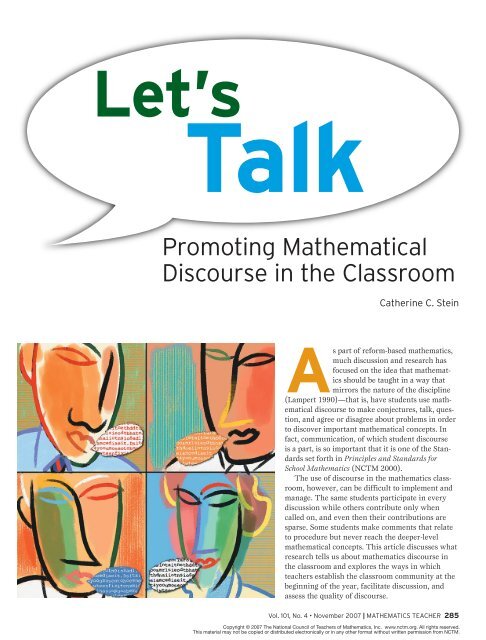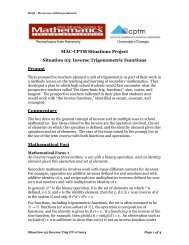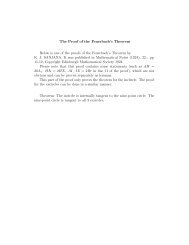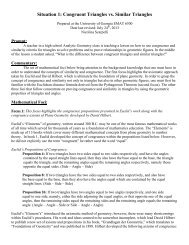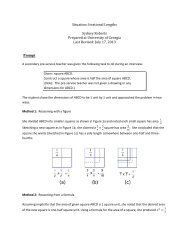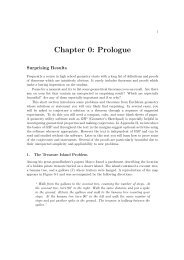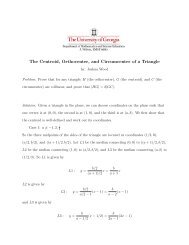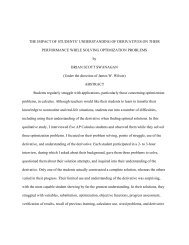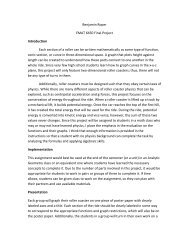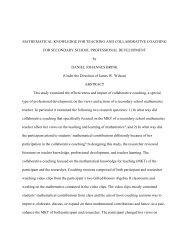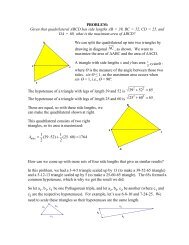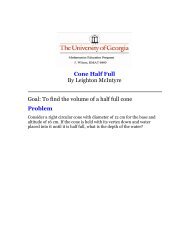Promoting Mathematical Discourse in the classroom
Promoting Mathematical Discourse in the classroom
Promoting Mathematical Discourse in the classroom
Create successful ePaper yourself
Turn your PDF publications into a flip-book with our unique Google optimized e-Paper software.
Let’sTalk<strong>Promot<strong>in</strong>g</strong> <strong>Ma<strong>the</strong>matical</strong><strong>Discourse</strong> <strong>in</strong> <strong>the</strong> ClassroomCa<strong>the</strong>r<strong>in</strong>e C. Ste<strong>in</strong>As part of reform-based ma<strong>the</strong>matics,much discussion and research hasfocused on <strong>the</strong> idea that ma<strong>the</strong>maticsshould be taught <strong>in</strong> a way thatmirrors <strong>the</strong> nature of <strong>the</strong> discipl<strong>in</strong>e(Lampert 1990)—that is, have students use ma<strong>the</strong>maticaldiscourse to make conjectures, talk, question,and agree or disagree about problems <strong>in</strong> orderto discover important ma<strong>the</strong>matical concepts. Infact, communication, of which student discourseis a part, is so important that it is one of <strong>the</strong> Standardsset forth <strong>in</strong> Pr<strong>in</strong>ciples and Standards forSchool Ma<strong>the</strong>matics (NCTM 2000).The use of discourse <strong>in</strong> <strong>the</strong> ma<strong>the</strong>matics <strong>classroom</strong>,however, can be difficult to implement andmanage. The same students participate <strong>in</strong> everydiscussion while o<strong>the</strong>rs contribute only whencalled on, and even <strong>the</strong>n <strong>the</strong>ir contributions aresparse. Some students make comments that relateto procedure but never reach <strong>the</strong> deeper-levelma<strong>the</strong>matical concepts. This article discusses whatresearch tells us about ma<strong>the</strong>matics discourse <strong>in</strong><strong>the</strong> <strong>classroom</strong> and explores <strong>the</strong> ways <strong>in</strong> whichteachers establish <strong>the</strong> <strong>classroom</strong> community at <strong>the</strong>beg<strong>in</strong>n<strong>in</strong>g of <strong>the</strong> year, facilitate discussion, andassess <strong>the</strong> quality of discourse.Vol. 101, No. 4 • November 2007 | Ma<strong>the</strong>matics Teacher 285Copyright © 2007 The National Council of Teachers of Ma<strong>the</strong>matics, Inc. www.nctm.org. All rights reserved.This material may not be copied or distributed electronically or <strong>in</strong> any o<strong>the</strong>r format without written permission from NCTM.
Tra<strong>in</strong> 1 Tra<strong>in</strong> 2 Tra<strong>in</strong> 3Adapted from Phillips et al. (1991), pp. 49–50Fig. 1 Hexagon perimeter tra<strong>in</strong>SETTING THE STAGEHow do I set up <strong>the</strong> <strong>classroom</strong> community to encouragestudents to participate?Teachers send messages about what is importantto <strong>the</strong>m by <strong>the</strong> way <strong>the</strong>y establish <strong>the</strong>ir <strong>classroom</strong>community. Of course, accuracy is essential <strong>in</strong>ma<strong>the</strong>matics, but to encourage discourse, teachersmust show students that <strong>the</strong>y value understand<strong>in</strong>gconcepts ra<strong>the</strong>r than just gett<strong>in</strong>g <strong>the</strong> right answer.Turner et al. (2003) grouped <strong>the</strong> messages thatteachers send <strong>in</strong>to four categories: (1) messagesabout tasks, learn<strong>in</strong>g, and expectations for students;(2) relationships with <strong>the</strong> teacher; (3) relationshipsamong students; and (4) rules and managementstructures. Teachers <strong>in</strong> <strong>classroom</strong>s supportive ofdiscourse showed enthusiasm for learn<strong>in</strong>g, setexpectations that all students would learn, andestablished <strong>classroom</strong> relationships and managementsystems based on respect.One could rightly argue that <strong>the</strong>se pr<strong>in</strong>ciples forestablish<strong>in</strong>g a community are true of <strong>classroom</strong>s <strong>in</strong>general and are not specific to ma<strong>the</strong>matics <strong>classroom</strong>sand ma<strong>the</strong>matics <strong>classroom</strong> discourse. Yackeland Cobb (1996), however, argue that establish<strong>in</strong>g ama<strong>the</strong>matical community also <strong>in</strong>cludes socioma<strong>the</strong>maticalnorms, <strong>the</strong> norms of <strong>the</strong> ma<strong>the</strong>matics community.Although <strong>the</strong>se norms may never be overtlystated, through discussion <strong>the</strong> teacher and studentscome to an understand<strong>in</strong>g about what counts asma<strong>the</strong>matical difference, sophistication, and explanation.Consider two students’ responses to a taskthat asks <strong>the</strong>m to f<strong>in</strong>d a rule for determ<strong>in</strong><strong>in</strong>g <strong>the</strong>perimeter of any given hexagon tra<strong>in</strong> (see fig. 1).Student 1Solution: p = 4(n – 2) + 10Explanation: The middle blocks of <strong>the</strong> tra<strong>in</strong> havefour sides out of six total sides that can be counted<strong>in</strong> <strong>the</strong> perimeter. So n equals <strong>the</strong> number of blocks.I took away <strong>the</strong> two blocks on <strong>the</strong> end s<strong>in</strong>ce I’monly count<strong>in</strong>g <strong>the</strong> middle. Then I multiplied by fourto f<strong>in</strong>d <strong>the</strong> number of sides that can be counted for<strong>the</strong> perimeter. The two end blocks each have fivesides show<strong>in</strong>g, so I added ten.Student 2Solution: p = 4n + 2Explanation: Each hexagon has at least four sideson <strong>the</strong> outside of <strong>the</strong> tra<strong>in</strong>, so I multiplied four by<strong>the</strong> number of hexagons (n). The hexagons on <strong>the</strong>end have one extra side, so I added two for <strong>the</strong> twosides on <strong>the</strong> end.Are <strong>the</strong> two solutions different ma<strong>the</strong>matically?Are <strong>the</strong> solutions efficient? Are <strong>the</strong> explanationsprovided acceptable? The answers to <strong>the</strong>se questionswill be negotiated as <strong>the</strong> <strong>classroom</strong> communityparticipates <strong>in</strong> discourse, but <strong>the</strong>y will ultimatelydepend on <strong>the</strong> teacher. Teachers send bo<strong>the</strong>xplicit and hidden messages about what <strong>the</strong>y value<strong>in</strong> ma<strong>the</strong>matics and what <strong>the</strong>y expect of students.FACILITATING DISCOURSEMy students understand <strong>the</strong> expectations and norms.Now what do I do?There is a misconception that <strong>the</strong> shift toward <strong>the</strong>use of <strong>classroom</strong> discourse <strong>in</strong> teach<strong>in</strong>g ma<strong>the</strong>maticsmeans that <strong>the</strong> teacher simply presents <strong>the</strong> problemand <strong>the</strong>n stands aside while students discussand solve it (Chazan and Ball 1995). The teacher’s<strong>in</strong>structional role is perceived as “don’t tell <strong>the</strong>answer.” This perception severely underrates <strong>the</strong>complexity of <strong>the</strong> teacher’s role <strong>in</strong> <strong>classroom</strong> discourse(Chazan and Ball 1995). So what shouldteachers do dur<strong>in</strong>g discussions to <strong>in</strong>crease participationand conceptual understand<strong>in</strong>g? There aretwo aspects of teacher discourse to be considered:cognitive discourse and motivational discourse.Cognitive discourse refers to what <strong>the</strong> teachersays to promote conceptual understand<strong>in</strong>g of <strong>the</strong>ma<strong>the</strong>matics itself. Kazemi and Stipek (1997)found that some <strong>in</strong>quiry-based <strong>classroom</strong>s,described as low-press, are still not effective <strong>in</strong>facilitat<strong>in</strong>g student discourse because <strong>the</strong>y focusonly on explanations of procedure and do not l<strong>in</strong>kto a conceptual understand<strong>in</strong>g of ma<strong>the</strong>matics. In<strong>the</strong> follow<strong>in</strong>g example, a teacher and a student arediscuss<strong>in</strong>g <strong>the</strong> student’s solution to <strong>the</strong> SkeletonTower problem (see fig. 2).286 Ma<strong>the</strong>matics Teacher | Vol. 101, No. 4 • November 2007
Tower 1 Tower 2 Tower 3Use <strong>the</strong> blocks to build <strong>the</strong> fourth tower <strong>in</strong> <strong>the</strong>sequence. How many cubes did you use? Howmany cubes would you need to build <strong>the</strong> fifthtower? The 12th tower? The 20th tower? The100th tower? Write a rule to help you f<strong>in</strong>d <strong>the</strong>number of cubes for <strong>the</strong> nth tower.Adapted from Stoker (2006)Fig. 2 Skeleton Tower problemMs. D. Please expla<strong>in</strong> how you found <strong>the</strong> rule for<strong>the</strong> towers.S. The center of each tower has <strong>the</strong> same number ofcubes as <strong>the</strong> tower number, so that equals n cubes.Ms. D. Okay, <strong>the</strong>n what?S. There are four arms com<strong>in</strong>g out from <strong>the</strong> center<strong>in</strong> <strong>the</strong> shape of triangles.Ms. D. Triangles?S. Yeah, when you flip <strong>the</strong>m over you get two rectangles.The height of <strong>the</strong> rectangle is <strong>the</strong> same as<strong>the</strong> center, and <strong>the</strong> width is one less. So2n(n – 1) + n gives you <strong>the</strong> number of cubes.Ms. D. 2n(n – 1) + n. Does everyone agree? [“Yeahs”heard from around <strong>the</strong> room.] Does everyoneunderstand how he got <strong>the</strong> answer? [More “yeahs”from <strong>the</strong> class.] Okay, who else has a solution?In contrast, <strong>in</strong> high-press <strong>classroom</strong>s, teacherspush students to l<strong>in</strong>k <strong>the</strong> strategies and proceduresused to <strong>the</strong> underly<strong>in</strong>g concepts. The follow<strong>in</strong>gexchange beg<strong>in</strong>s <strong>in</strong> <strong>the</strong> same way as <strong>the</strong> previousone. In this example, however, <strong>the</strong> teacher presses<strong>the</strong> student for more <strong>in</strong>formation about his th<strong>in</strong>k<strong>in</strong>g.S. The center of each tower has <strong>the</strong> same number ofcubes as <strong>the</strong> tower number, so that equals n cubes.Ms. K. Okay, <strong>the</strong>n what?S. There are four arms com<strong>in</strong>g out from <strong>the</strong> center<strong>in</strong> <strong>the</strong> shape of triangles.Ms. K. Can you expla<strong>in</strong> what you mean bytriangles?S. The cubes look like <strong>the</strong> shape of a triangle.Ms. K. Let’s be sure everyone understands. Can youshow us one of <strong>the</strong> triangles on <strong>the</strong> model youbuilt of <strong>the</strong> fourth tower?S. Sure. When you look at one of <strong>the</strong> arms com<strong>in</strong>gout from <strong>the</strong> center [pulls <strong>the</strong> cubes away from<strong>the</strong> rest of <strong>the</strong> model], you have a piece with threecubes on <strong>the</strong> bottom, two on <strong>the</strong> middle level,and one on <strong>the</strong> top level. It looks like a triangle.Ms. K. Okay, I see. Why are <strong>the</strong> trianglesimportant?S. Because if I can figure out how many cubes are<strong>in</strong> <strong>the</strong> triangles for each tower, I can add thatnumber to <strong>the</strong> center tower and figure out howmany cubes total. [The exchange cont<strong>in</strong>ues as <strong>the</strong>student cont<strong>in</strong>ues expla<strong>in</strong><strong>in</strong>g.]In addition to help<strong>in</strong>g students make connections,teachers of high-press <strong>classroom</strong>s take better advantageof help<strong>in</strong>g students learn from mistakes andstress <strong>in</strong>dividual accountability so that all studentsare engaged.The issue of engagement necessitates <strong>the</strong> secondtype of teacher discourse, motivational discourse.Motivational discourse refers not only to praiseoffered to students but also to supportive and nonsupportivestatements teachers make that encourageor discourage participation <strong>in</strong> ma<strong>the</strong>matics<strong>classroom</strong> discussions. Students’ lack of participation<strong>in</strong> <strong>classroom</strong> discourse can be a result of selfhandicapp<strong>in</strong>g,failure avoidance, or a preference foravoid<strong>in</strong>g novelty (Turner et al. 2002). Sometimesstudents who disagree rema<strong>in</strong> silent ra<strong>the</strong>r thanexpress a ma<strong>the</strong>matical argument (Lampert 1990).Turner et al. (2002) found that when teachers usedsupportive motivational discourse <strong>in</strong> addition topress<strong>in</strong>g for conceptual understand<strong>in</strong>g, <strong>the</strong> reportedlevels of <strong>the</strong>se behaviors decreased.Supportive motivational discourse occurs whenteachers focus on learn<strong>in</strong>g through mistakes, collaboration,persistence, and positive affect (Turneret al. 2003). Consider <strong>the</strong> follow<strong>in</strong>g exchange <strong>in</strong>which a student expla<strong>in</strong>s her solution to <strong>the</strong> teacher.Ms. K. Expla<strong>in</strong> to <strong>the</strong> class how you built <strong>the</strong> fourthtower.Susan. It doesn’t look like <strong>the</strong> picture.Ms. K. If you expla<strong>in</strong> how you thought about it, maybewe can help you figure out where you’re mak<strong>in</strong>g amistake. I see some o<strong>the</strong>r towers around <strong>the</strong> roomthat don’t look like <strong>the</strong> picture. As you th<strong>in</strong>k aloud,maybe toge<strong>the</strong>r we can figure out how to build it.Though this is a brief exchange, <strong>the</strong> messages sentby <strong>the</strong> teacher are clear. Mistakes are an opportunityfor learn<strong>in</strong>g, and <strong>the</strong> learn<strong>in</strong>g is a collaborativeprocess <strong>in</strong> which all students are expected to participate.Conversely, nonsupportive motivationaldiscourse occurs when teachers emphasize gett<strong>in</strong>g<strong>the</strong> right answers without mistakes, compare orhighlight <strong>in</strong>dividual successes or failures, or usesarcasm or humiliation (Turner et al. 2003).Vol. 101, No. 4 • November 2007 | Ma<strong>the</strong>matics Teacher 287
Table 1Levels of <strong>Discourse</strong> <strong>in</strong> a Ma<strong>the</strong>matics ClassroomLevelsCharacteristics of <strong>Discourse</strong>0 The teacher asks questions and affirms <strong>the</strong> accuracy of answers or <strong>in</strong>troduces and expla<strong>in</strong>sma<strong>the</strong>matical ideas. Students listen and give short answers to <strong>the</strong> teacher’s questions.1 The teacher asks students direct questions about <strong>the</strong>ir th<strong>in</strong>k<strong>in</strong>g while o<strong>the</strong>r students listen.The teacher expla<strong>in</strong>s student strategies, fill<strong>in</strong>g <strong>in</strong> any gaps before cont<strong>in</strong>u<strong>in</strong>g to presentma<strong>the</strong>matical ideas. The teacher may ask one student to help ano<strong>the</strong>r by show<strong>in</strong>g how to doa problem.2 The teacher asks open-ended questions to elicit student th<strong>in</strong>k<strong>in</strong>g and asks students to commenton one ano<strong>the</strong>r’s work. Students answer <strong>the</strong> questions posed to <strong>the</strong>m and voluntarilyprovide additional <strong>in</strong>formation about <strong>the</strong>ir th<strong>in</strong>k<strong>in</strong>g.3 The teacher facilitates <strong>the</strong> discussion by encourag<strong>in</strong>g students to ask questions of oneano<strong>the</strong>r to clarify ideas. Ideas from <strong>the</strong> community build on one ano<strong>the</strong>r as students thoroughlyexpla<strong>in</strong> <strong>the</strong>ir th<strong>in</strong>k<strong>in</strong>g and listen to <strong>the</strong> explanations of o<strong>the</strong>rs.Adapted from Hufferd-Ackles, Fuson, and Sher<strong>in</strong> (2004)The follow<strong>in</strong>g encounter provides an example ofnonsupportive motivational discourse <strong>in</strong> which <strong>the</strong>teacher is more concerned with <strong>the</strong> right answerthan with <strong>the</strong> student’s th<strong>in</strong>k<strong>in</strong>g about <strong>the</strong> task.Ms. D. Expla<strong>in</strong> how you built <strong>the</strong> fourth tower.Bill. [Holds up <strong>the</strong> tower he built with his partner.]Ms. D. This is not <strong>the</strong> fourth tower <strong>in</strong> <strong>the</strong> pattern.Does it look like it should be? You should beable to build it with a picture. The first level has1 cube; <strong>the</strong> second level has 5; <strong>the</strong> third level has9. It’s go<strong>in</strong>g up by 4 each time. So, how manycubes <strong>in</strong> <strong>the</strong> fourth level?Bill. Thirteen.Ms. D. N<strong>in</strong>e plus four equals thirteen. Now buildit like <strong>the</strong> picture. Who th<strong>in</strong>ks <strong>the</strong>y have it right?As <strong>the</strong>se examples <strong>in</strong>dicate, <strong>the</strong> teacher’s role <strong>in</strong> discourseis complex. Teachers must be conscious about<strong>the</strong> statements <strong>the</strong>y make and <strong>the</strong> questions <strong>the</strong>y askso that all students are encouraged to participate.ASSESSING DISCOURSEHow do I know if <strong>the</strong> discourse <strong>in</strong> my <strong>classroom</strong> issuccessful?Ma<strong>the</strong>matics discourse does not happen overnight,particularly if students have experienced onlyteacher-directed, procedure-oriented ma<strong>the</strong>matics<strong>classroom</strong>s. As a result, ma<strong>the</strong>matics <strong>classroom</strong>discourse is a dynamic process that is often hard toassess. Hufferd-Ackles, Fuson, and Sher<strong>in</strong> (2004)created a framework to describe and evaluate <strong>the</strong>process a class goes through when discourse is<strong>in</strong>troduced. Four categories are exam<strong>in</strong>ed—question<strong>in</strong>g,explanation of ma<strong>the</strong>matical th<strong>in</strong>k<strong>in</strong>g,source of ma<strong>the</strong>matical ideas, and responsibilityfor learn<strong>in</strong>g. A scale of 0 to 3 is used, where level0 refers to a traditional, teacher-directed class, andlevel 3 is reached when <strong>the</strong> teacher participatesas a member of <strong>the</strong> community and assists only asneeded (see table 1). Although this frameworkserves as a good <strong>in</strong>dicator for assess<strong>in</strong>g <strong>the</strong> discourselevel of <strong>the</strong> whole class, it does not assess<strong>in</strong>dividual students. Teachers need to be aware ofhow <strong>in</strong>dividual students are participat<strong>in</strong>g so that<strong>the</strong>y can encourage and scaffold students who arenot participat<strong>in</strong>g <strong>in</strong> <strong>the</strong> discourse.CONCLUSIONParticipat<strong>in</strong>g <strong>in</strong> a ma<strong>the</strong>matical community throughdiscourse is as much a part of learn<strong>in</strong>g ma<strong>the</strong>maticsas <strong>the</strong> conceptual understand<strong>in</strong>g of <strong>the</strong> ma<strong>the</strong>maticsitself. As students learn to make and test conjectures,question, and agree or disagree about problems, <strong>the</strong>yare learn<strong>in</strong>g <strong>the</strong> essence of what it means to do ma<strong>the</strong>matics.If all students are to be engaged, teachers mustfoster <strong>classroom</strong> discourse by provid<strong>in</strong>g a welcom<strong>in</strong>gcommunity, establish<strong>in</strong>g norms, us<strong>in</strong>g supportivemotivational discourse, and press<strong>in</strong>g for conceptualunderstand<strong>in</strong>g. As Johnston (2004) puts it, “In o<strong>the</strong>rwords, <strong>the</strong> language that teachers (and <strong>the</strong>ir students)use <strong>in</strong> <strong>classroom</strong>s is a big deal” (p. 10).REFERENCESChazan, D., and D. Ball. “Beyond Exhortations Not toTell: The Teacher’s Role <strong>in</strong> Discussion-IntensiveMa<strong>the</strong>matics Classes.” (Craft Paper 95-2). EastLans<strong>in</strong>g, MI: National Center for Research onTeacher Learn<strong>in</strong>g, 1995.Hufferd-Ackles, K., K. Fuson, and M. Sher<strong>in</strong>.“Describ<strong>in</strong>g Levels and Components of a Math-288 Ma<strong>the</strong>matics Teacher | Vol. 101, No. 4 • November 2007
Talk Learn<strong>in</strong>g Community.” Journal for Research <strong>in</strong>Ma<strong>the</strong>matics Education 35 (March 2004): 81–116.Johnston, P. Choice Words: How Our Language AffectsChildren’s Learn<strong>in</strong>g. Portland, ME: Stenhouse Publishers,2004.Kazemi, E., and D. Stipek. “Press<strong>in</strong>g Students to BeThoughtful: <strong>Promot<strong>in</strong>g</strong> Conceptual Th<strong>in</strong>k<strong>in</strong>g <strong>in</strong>Ma<strong>the</strong>matics.” Paper presented at <strong>the</strong> annual meet<strong>in</strong>gof <strong>the</strong> American Educational Research Association,Chicago, 1997.Lampert, M. “When <strong>the</strong> Problem Is Not <strong>the</strong> Questionand <strong>the</strong> Solution Is Not <strong>the</strong> Answer: <strong>Ma<strong>the</strong>matical</strong>Know<strong>in</strong>g and Teach<strong>in</strong>g.” American EducationResearch Journal 27 (Spr<strong>in</strong>g 1990): 29–63.National Council of Teachers of Ma<strong>the</strong>matics(NCTM). Pr<strong>in</strong>ciples and Standards for School Ma<strong>the</strong>matics.Reston, VA: NCTM, 2000.Phillips, E., with T. Gardella, C. Kelly, and J. Stewart.Patterns and Functions: Addenda Series, Grades5–8. Reston, VA: National Council of Teachers ofMa<strong>the</strong>matics, 1991.Stoker, J. “<strong>Promot<strong>in</strong>g</strong> <strong>the</strong> Professional Development ofMa<strong>the</strong>matics Teachers through Aligned AssessmentTasks.” 2006. www.aare.edu.au/01pap/sto01354.htm.Turner, J. C., D. K. Meyer, C. Midgley, and H. Patrick.“Teacher <strong>Discourse</strong> and Sixth Graders’ ReportedAffect and Achievement Behaviors <strong>in</strong> Two High-Mastery/High-Performance Ma<strong>the</strong>matics Classrooms.”Elementary School Journal 103 (March2003): 357–82.Turner, J., C. Midgley, D. Meyer, M. Gheen, E. Anderman,Y. Kang, and H. Patrick. “The ClassroomEnvironment and Students’ Reports of AvoidanceStrategies <strong>in</strong> Ma<strong>the</strong>matics: A Multimethod Study.”Journal of Educational Psychology 94 (March 2002):88–106.Yackel, E., and P. Cobb. “Socioma<strong>the</strong>matical Norms,Argumentation, and Autonomy <strong>in</strong> Ma<strong>the</strong>matics.”Journal for Research <strong>in</strong> Ma<strong>the</strong>matics Education 27(July 1996): 458–77. ∞CATHERINE STEIN, ccste<strong>in</strong>@uncg.edu, is a doctoral student at <strong>the</strong>University of North Carol<strong>in</strong>a atGreensboro, Greensboro, NC 27403.She is <strong>in</strong>terested <strong>in</strong> foster<strong>in</strong>g student participation<strong>in</strong> ma<strong>the</strong>matics <strong>classroom</strong> communities.Vol. 101, No. 4 • November 2007 | Ma<strong>the</strong>matics Teacher 289


